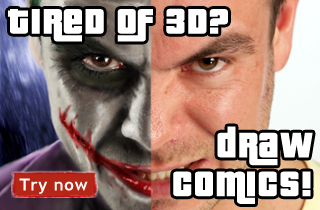"Advanced multi-channel texturing" by Ziv Qual
In other words – almost the entire texturing process of the character’s armor parts is done within Max through the UV’s using only one material and a few textures.
The end result of this is that all the armor’s parts (over 40 different objects in the blood knight case) use the same material with just a few textures, as opposed to the "classic" texturing method in which you end up with many materials and hundreds of texture files (assuming each material will have several textures for color / bump / specular etc’).
pros
– MAJOR RESOURCE SAVER
– all the armor parts use only 1 material and a few textures for everything.
– since many of the textures are applied in tiling, it allows for VERY HIGH RES details at the relative low resources cost
– Immediate feedback from within the viewport as to where details fall, this is especially helpful when working on things such as the side decorations which can be deformed specifically to the shape of the mesh (which is rather hard to do with uv’s / photoshop using "standard" methods).
– Ability to quickly clone your models and create many variations in the textures by simply altering the UVs (if I wanted to make many clones of this character with variations in the details such as scratches, blood stains, dirt, etc’
– I wouldn’t need to create new textures, just play around with each clone’s UV’S)
Cons
– Somewhat limited control for specific details ( making "global" textures that will be used for all the model’s parts kind of limits you if you want some parts to have unique details without making new textures specifically for them).
– The material tends to be heavy and give slow feedback in the material editor when "show end result" is on, due to it’s complexity. The more details you add, the heavier the material becomes and it does get harder to keep track of everything.
STEP1 – Getting started – mesh preparation and Base material
The base of this workflow begins at the modeling stage. The modeling process of all the armor’s parts was pretty similar:
Step1 – work on the base shape of the armor’s part and prepare it’s topology for the details to come with as few polygons as possible (note that It may seam I used more than the minimal amount of required polygons but that is only because the end result required many sharp corners) to be able to easily modify it later on if that would be required. these polygons receive polygon ID 1.
Step2 – Add Shell modifier to the model and set "Override Edge Mat ID" to 2. Once I decide the model’s base shape is final I collapse the shell to editable poly and modify the edge polygons a bit further as I find fit.
Step3 – Take advantage of the prepared topology from step 1 to extrude the polygons in (to prepare the socket), Change their ID into 3 and then extrude them out to create the diamonds.
Step4 – (optional) In some of the armor’s parts I’ve used another polygon ID – 4 for silver when I wanted more variation in the materials, this was also used for the sword’s blade.
Throughout the modeling process I’ve had the base material ready for early testing, the base material is made out of 100% procedural maps and that is why it did not require me to unwrap the model as I was still working on it, the complex final stage of the texturing only came once I’ve decided modeling was done. The base material is made out of a Multi sub object with 4 ID’s 1- The main armor’s metal, 2 – The armor’s outer gold, 3 – The diamonds, 4 – Silver. I will focus this tutorial on the main armor’s metal.
For the base main armor metal material (ID 1) I thought of going for a standard material But decided to go with Mental ray’s A&D shader because it supports blurry reflections, A decision that made the material pretty heavy but look good 🙂
The parameters I’ve decided to add maps to are Diffuse color, Bump, Glossiness, Reflection color. The idea is to add MATCHING maps with different color brightness levels to these parameters while keeping this in mind:
brighter colors mean:
diffuse color – brighter diffuse colors.
Bump – outer dents.
Glossiness – sharper reflections / highlights.
Reflection color – stronger reflections.
(Obviously, darker colors below 50% gray would mean the opposite).
The map I’ve created for these parameters was made out of a few procedural textures, this made it easy to control the brightness level of the colors for each of the parameters – for example – in one of the specific textures, I used a bright color for the dirt in the diffuse color but changed it to dark in the bump map to make it cause an inner dent and also dark in the reflection color because this dirt is supposed to be less reflective then the armor’s metal. Making the base material with procedural textures is also good because a simple combination of a few procedural textures can hold a very high res detail level at a low resource cost and every single armor part will have different detail features (as opposed to mapped texture files which tend have duplicated features look).
Advanced multi-channel texturing
2 comments
Leave a Reply
You must be logged in to post a comment.







supper like this tutorial …clear image and step by step walk through..
great thanks
Excelente tut…gracias, muy buen trabajo.